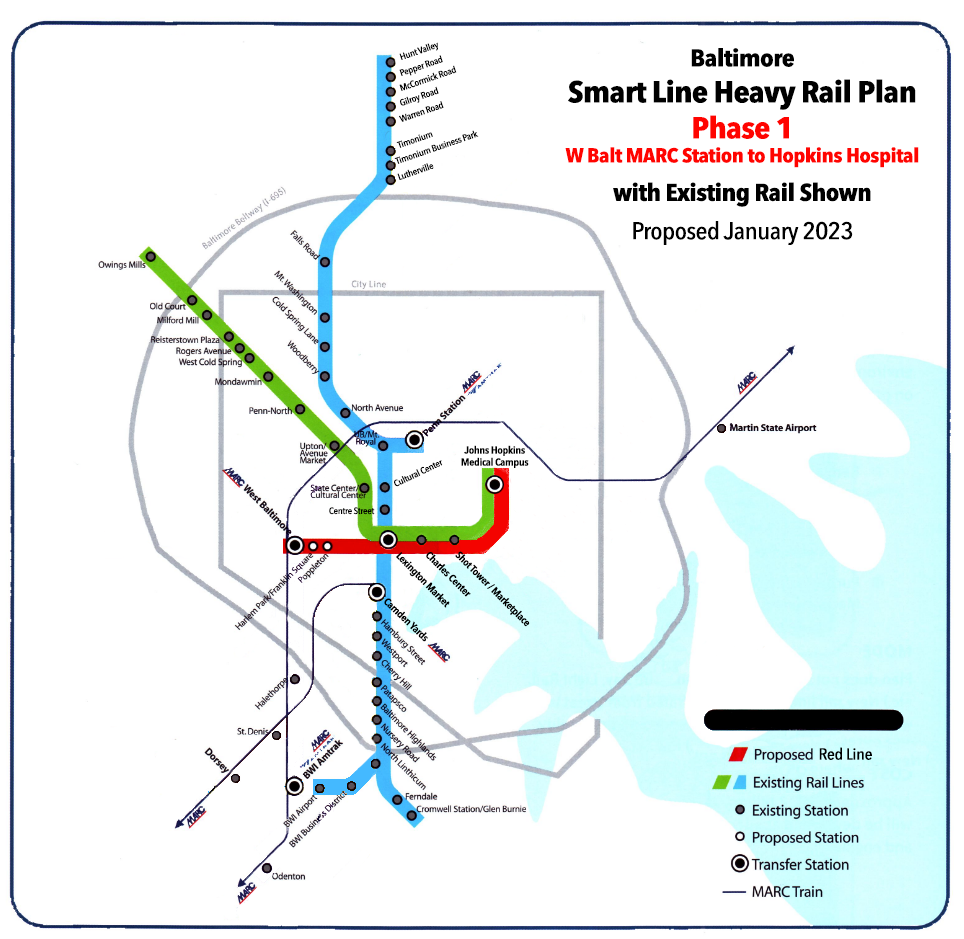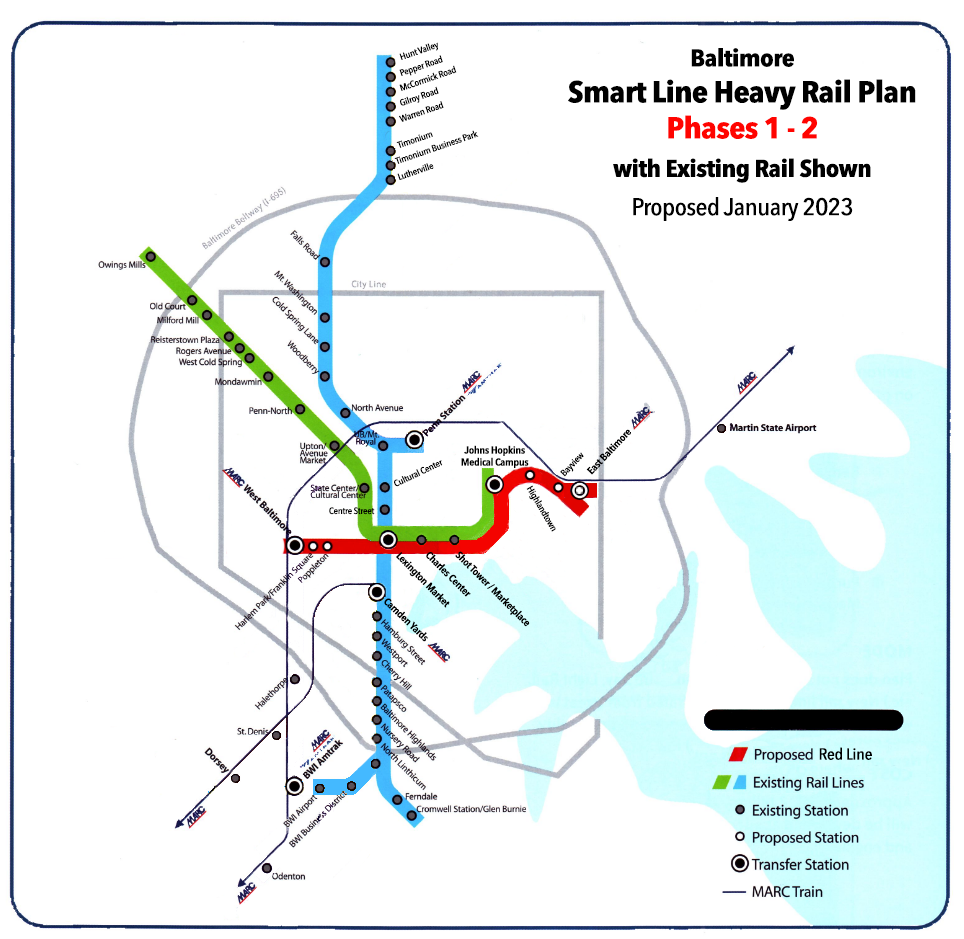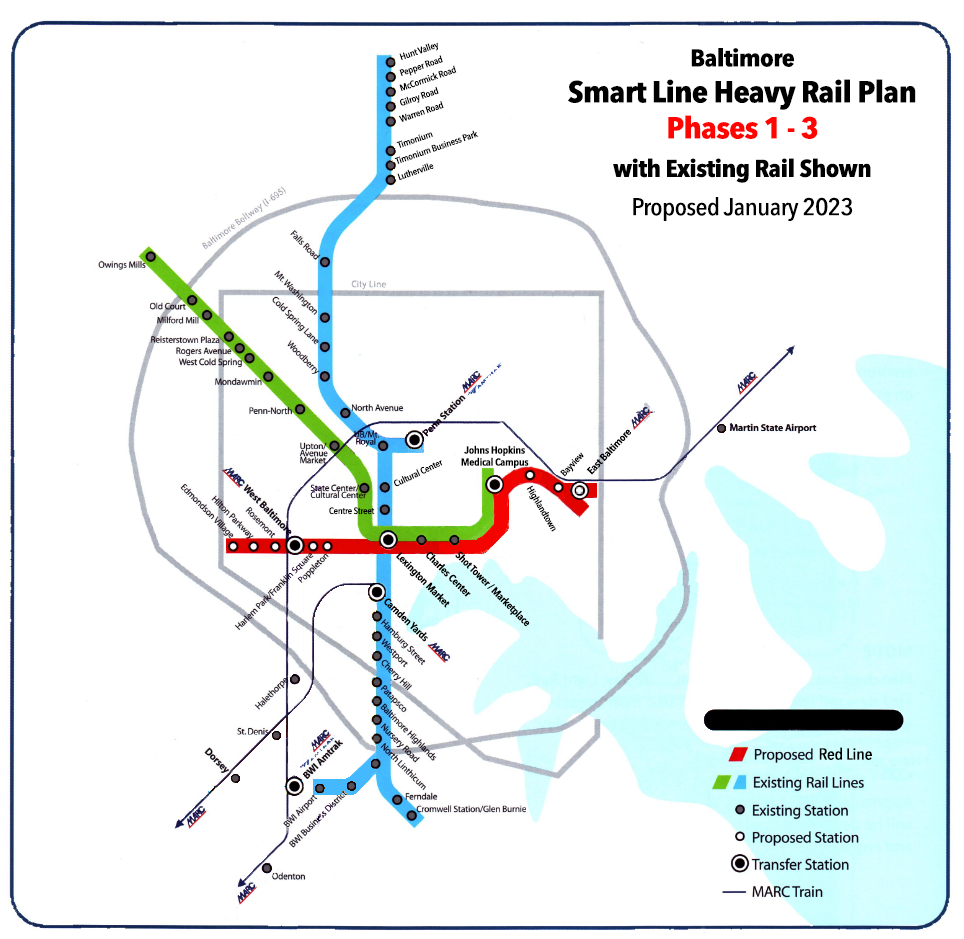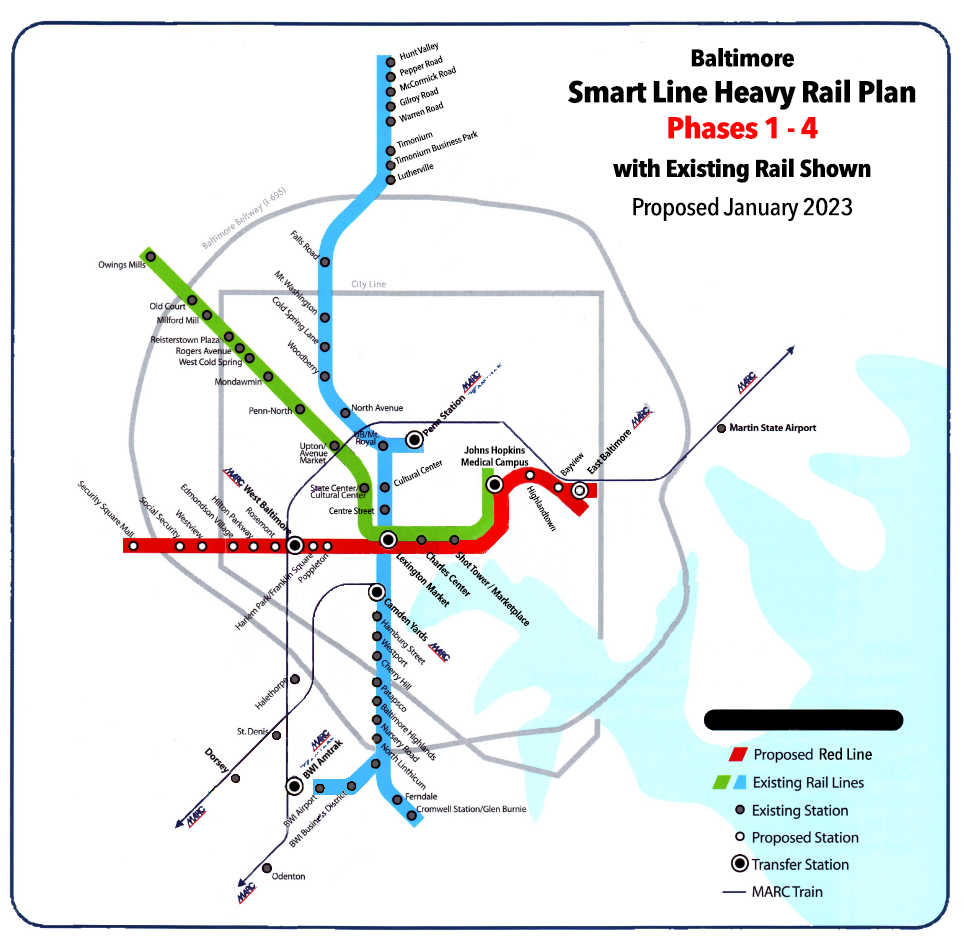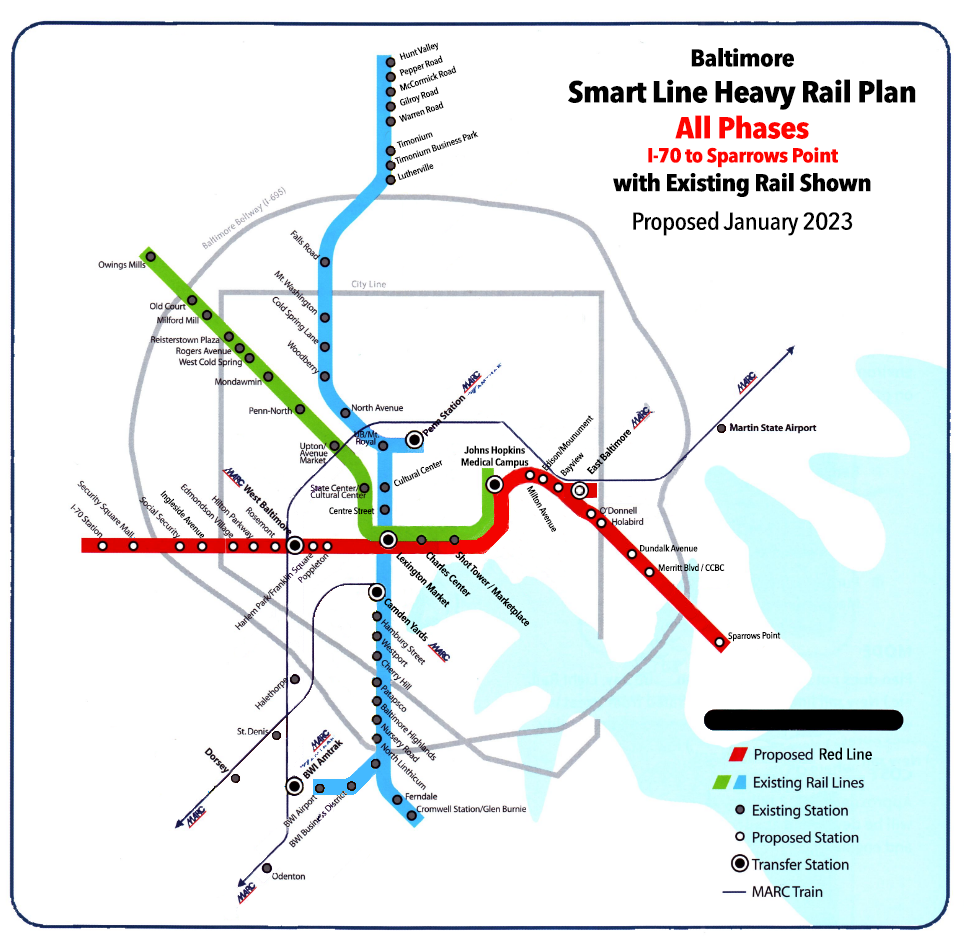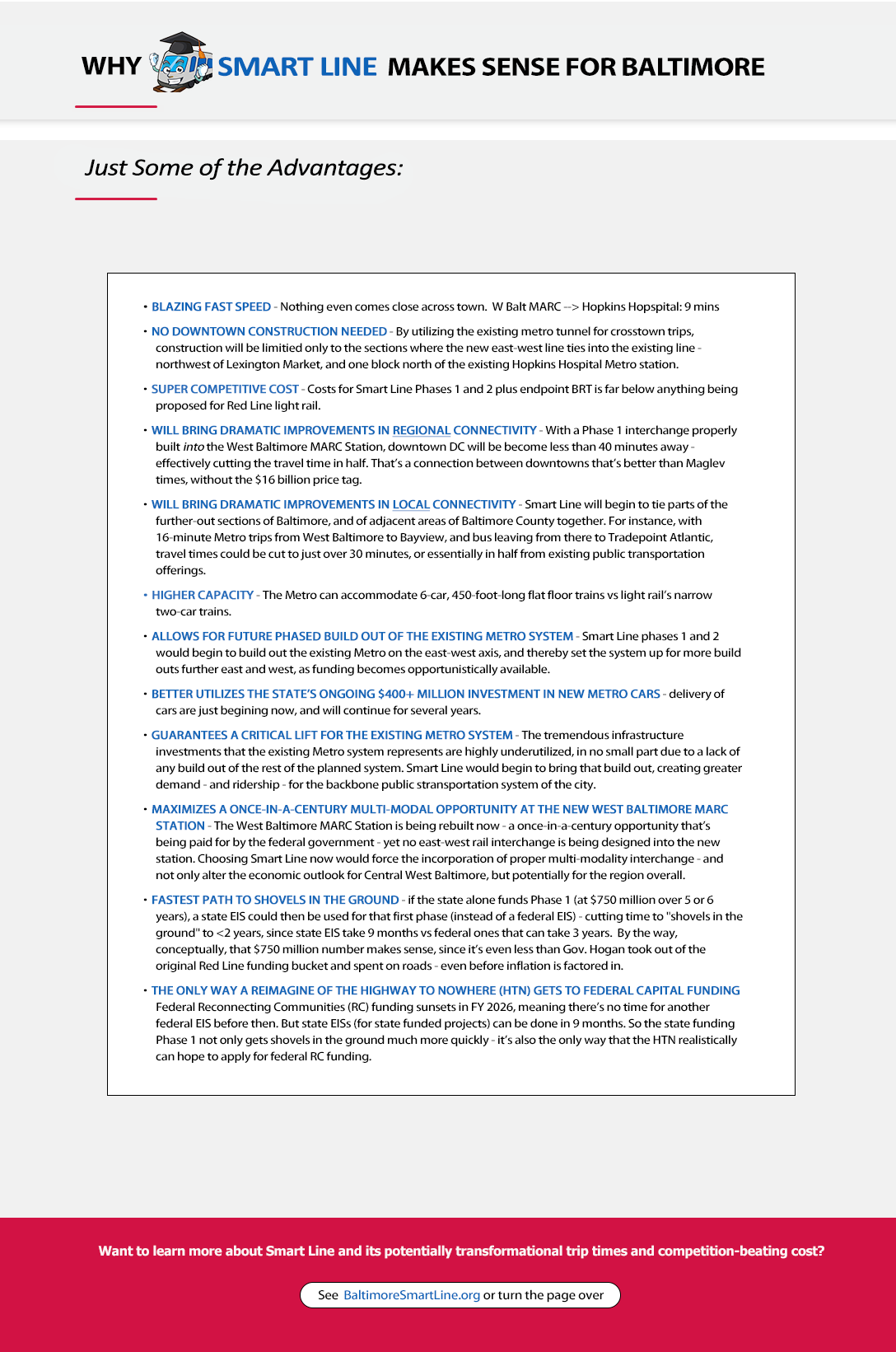Proposal Overview
The Goal:
Begin building out a truly-integrated, highly-functional, rapid mass transit system for Baltimore by utilizing the existing metro tracks and crosstown tunnel as the backbone for a new east-west heavy rail (subway) line.
Central Project Tenets:
Heavy Rail
Done in Phases - as a Program of Projects that Preserves Eligibility for Future Funding at Each Step
Ties Into the Existing Metro to Build the System’s Second Line
Utilizes the Existing Downtown Tunnel for Crosstown Trips
Only State Funding Used for Phase 1 - Allowing for Much Quicker Completion
10 Key Benefits:
1. Cheaper
At least for the first few segments. No new crosstown tunnel would be needed. The heavy-rail would instead tap into the existing crosstown tunnel at Lexington Market, potentially resulting in smaller initial price figures.
2. Allows for Phasing
If there’s no new tunnel cost that needs to be costed out over a longer route, the new line can be constructed in fiscally-swallowable chunks. Working in phases - or a program of discrete projects with eligibility preserved at each phase for future funding - would allow Governor Moore to hit his target of “getting the Red Line done”, by getting at least the first few phases done. Phases one and two could be nearing completion eight years from now, with other phases already in a design and financing pipeline.
3. Faster to Completion
Again, at least for the first few phases, with no new crosstown tunnel, and most of the first phase located inside the existing Highway to Nowhere segregated trench, the time to completion of Phases 1 (and potentially even Phases 2 and 3) would be less than a comparable segment of the Red Line light rail plan.
4. Better Service
Subways are faster than surface light rail – often dramatically. And because they run primarily underground, that means less disruption from weather – so they’re more trusted, more dependable, more widely utilized by riders and therefore more likely to spur development. Metro heavy rail (subway) also accommodates wider six-car trains, triple the capacity of the narrow two-car trains of the cancelled Red Line light rail project.
5. Boosts Regional Ties
The linchpin of Smart Line on the west side of the city is the West Baltimore MARC Station, the closest rail station in Baltimore to Washington, DC, and the fastest way to get to downtown DC without a helicopter. With just the first phase of Smart Line in place, one could easily envision a 45-minute one-transfer trip between downtown DC and Downtown Baltimore. Those are MAGLEV times without the $16 billion price tag and $60 one-way tickets.
6. The Most Disinvested Areas Are the First Beneficiaries
The first couple of phases of Smart Line are focused on the West Baltimore Route 40 corridor, where what are arguably Maryland’s most disinvested communities sit. Rather than having to wait decades for a full tunnel and line to be built, just building Phase 1 of Smart Line instantly ties West Baltimore all the way to the MARC Station directly into downtown and over to the East Side of the city. An hour and a half trip with transfers on a bus becomes a quick one-seat ticket to jobs.
7. Expedites Highway to Nowhere Reimagine
If Phase One of Smart Line runs in the Highway to Nowhere (HTN) right-of-way, and is built on an accelerated schedule without a federal Environmental Impact Study (because only state funds are used), then this means decisions would have to be made immediately about what to do in this high-profile West Baltimore HTN corridor. Needing to expedite Smart Line means needing to expedite the final HTN decisions, and that’s critical - because our last chance to apply for funds for the HTN from the 2021 federal Reconnecting Communities program is the Summer of 2025. All design, environment and engineering approvals need to the done by then - the only way that happens is Smart Line with state funds.
8. Seizes the Design Opportunity with Amtrak at the West Baltimore MARC Station
A new West Baltimore MARC Station is being designed and built for free right now by Amtrak (as part of its Douglass/B&P Tunnel project), but the design timeline is not waiting for any decisions to be made at the State level on east-west rail. Consequently, there is currently no local rail interchange being designed into the new station - there’s not even any structural accommodation being scoped in. Deciding to build Smart Line starting with Phase 1 would change all that. A new station interchange would have to be designed in, saving the massive expense of having to use State and City funds to retrofit that in later.
9. Better Utilization of Existing Rail Resources
The currently-existing Baltimore crosstown metro tunnel is only being used at approximately 20% of its capacity. Connecting Smart Line east-west rail trains into that tunnel on the same tracks would dramatically boost the utilization of that super expense piece of existing infrastructure, with little operational downside. And if the tunnel is at that level of utilization, so are many of the stations in and around the tunnel. Building Smart Line means better utilization of Baltimore existing Green Line.
10. Smarter Locations of Track Right-of-Ways
Right-of-ways - or the paths on which the rail tracks would sit - were a huge source of contention for the attempt a decade ago to the build the light rail “Red Line”, particularly on the east side of the Baltimore. Smart Line avoids many of those same controversies by adhering to existing rail right-of-ways north of Hopkins Hospital that allow the line to both tie-in major job centers, like Hopkins Hospital and Bayview, and also pull riders from high-density areas on both sides of the line. Smart Line track alignments are, well… smarter.

